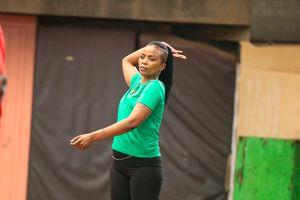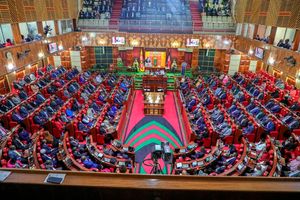
Russian Foreign Minister Sergey Lavrov meets President William Ruto and other Kenyan leaders at State House Nairobi on May 29, 2023.
| PSCNews
Premium
Inside Russia’s fertiliser diplomacy and Kenya’s place in it
The Russians were in town – and State House. In Mombasa, some free fertiliser arrived. In the old days of the Cold War, that would have raised eyebrows from Nairobi to Washington.
Coming as Russia continues with its war with Ukraine, the intention of Foreign Minister Sergei Lavrov Africa tour, diplomats say, is to get African countries to take a neutral stand over the conflict.
In all his stops, he has said that Russia is not the aggressor and is actually defending itself against Ukrainian aggression. He has also claimed that Ukraine is conducting genocide against Russian speakers.
Lavrov is not your run-of-the-mill diplomat. He has held his position since 2004, making him the longest-serving foreign minister in Russia since the fall of the Soviet Union.
His Nairobi visit coincided with the arrival in Mombasa of 30,000 tonnes of free Russian fertiliser. In line with the UN blockade, Latvia seized the fertiliser, and Moscow suggested that it be donated to impoverished African nations.
The fertiliser was then handed over to the United Nations’ World Food Programme, which donated it to Kenya. Interestingly, the same cargo now forms part of Russia’s fertiliser diplomacy.
The fertiliser came from Uralchem-Uralkali, whose founder is the Russian oligarch, Dmitry Mazepin, the billionaire targeted by UN sanctions over his association with Russian leader Vladimir Putin. Mazepin was forced to sell his controlling stake in the fertiliser company to enable it to avoid sanctions. The fertiliser from his company informs part of Lavrov’s Africa tour.
The Russian News Service, Tass, quoted Lavrov in Nairobi, saying that "several more countries will receive our fertilisers".
He blamed the European Union nations for "sabotage" over the "extremely slow" process of releasing the fertiliser. Other countries set to receive the free cargo include Malawi and Nigeria.
With rising fertiliser prices since 2020, Russia is now using the commodity as a geopolitical tool to entrench itself in various African nations. Whether that will pay dividends will be seen in diplomatic circles when Kenya is asked to vote against Moscow.
Kenya has also been pursuing tractor deals with Belarus which, too, has faced sanctions over its support for Russia in the ongoing Ukraine crisis. After the sanctions affected about 70 per cent of its exports to the EU and about 17 per cent of its total exports, Belarus turned to African nations for business, explaining the proposed controversial tractor deal with Kenya.
But beyond the current Ukraine politics and fertiliser diplomacy, Kenya has a colourful history with Russia – perhaps more than is known to the public. Russia’s biggest imprint in Kenya remains the modern-day Jaramogi Oginga Odinga Referral and Teaching Hospital, previously known as New Nyanza General Hospital.
Financed projects
Brokered by Vice-President Oginga Odinga, the facility was one of the Russian satellite projects of the 1960s that were being informed by the Cold War. First President Jomo Kenyatta laid the foundation stone on July 28, 1965, accompanied by Soviet Ambassador V. S. Lavrov. But after the falling-out between Jaramogi and Kenyatta, the hospital would not be opened until 1969 – the day Kenyatta was stoned in Kisumu.

Agriculture Cabinet Secretary Mithika Linturi (second right) with Russian Ambassador to Kenya Dmitry Maksimychev and Solomon Ondego, the Deputy Director of Grain Bulk Handlers at the Port of Mombasa to receive the 34, 000 tonnes of fertiliser from Russia on May 31, 2023.
While the Soviet Union had agreed to finance several projects, including a hospital, a cotton mill, a radio station, a fish canning factory and a processing factory for fruit and vegetables, only the hospital project materialised. The others were caught up in Cold War politics, and no politician wanted to replace Odinga as the main broker on Russian ventures.
It is also said that the Kenya government was dissatisfied with the conditions set by the Russians, that the local cost of the projects be financed via commodity credits. That meant that Russia would send its goods to Kenya National Trading Company and that they would be sold locally. Kenya would keep the cash to finance the local component of the project. Kenya rejected the proposal and asked for cash. When that was not forthcoming, it cancelled the projects.
Another early project financed by Russia was the Lumumba Institute to train Kanu officials. Located in Ruaraka — on the grounds of the current Pan Africa Christian University — the institute was also caught up in the wars between the East and West, and the two Russian "instructors", Alexei Zdravomyslova and Andrei Bogdanov, who were teaching ‘Principles of Socialism’ — the Leninist art of political action — were asked to leave. The institute, Jaramogi’s brainchild, was built with donations from Eastern Europe.
In those days, dealing with Russians and Chinese drew suspicion in Western circles — even as Kenya claimed to be non-aligned. Thus, when former Kadu president Ronald Ngala, then Kilifi South MP, demanded the closure of the Lumumba Institute, Jaramogi’s loyal lieutenant, Mr Luke Obok, reacted: "If Mr Ngala is upset by the presence of some Russian teachers on the staff of the institute, as a good nationalist he should also demand and agitate the nationalisation of several other institutions in Kenya which are run and controlled by Americans, the British, Germans and Israelis."
He meant the Kenya Institute of Administration, then under the Americans, and the National Youth Service, which was an Israeli project.
Another controversy arose when Russia donated massive tanks to the Kenya army. The arrival of the arms in Kenya seemed to symbolise that Kenya had decided to shift to a new military ally – Russia. It was not surprising when the Minister of State, James Nyamweya, told Parliament that the government had rejected the offer because the tanks were old.
This writer once asked former Attorney-General Charles Njonjo about those World War II tanks, and he told me that they were massive and “could not pass on any Kenyan bridge...we went to see them in Mombasa and could not allow them in”.
During that period, Odinga, who had asked for the donation, was accused by Nyamweya of “pulling the country to the East, while the government was pulling to the centre”.
In his book, Not Yet Uhuru, Odinga says “The consignment was ordered officially by the Kenya government... the very government that had ordered the arms sent ministers Njoroge Mungai, Bruce McKenzie and Joe Murumbi to Mombasa, where they examined the shipment and reported that the arms were second-hand. Tom Mboya said in Parliament that Soviet aid was not worth getting. The arms were turned back”.
Today, the Russians are no longer providing arms. Instead, it appears that fertiliser has become the biggest weapon the country can offer African nations. With the William Ruto government making bulk purchases as part of the subsidised fertiliser programme, this is a clear market for Russia, which is battling for space with the other major supplier, Morocco, which has also been sending its own diplomats.
[email protected] @johnkamau1





